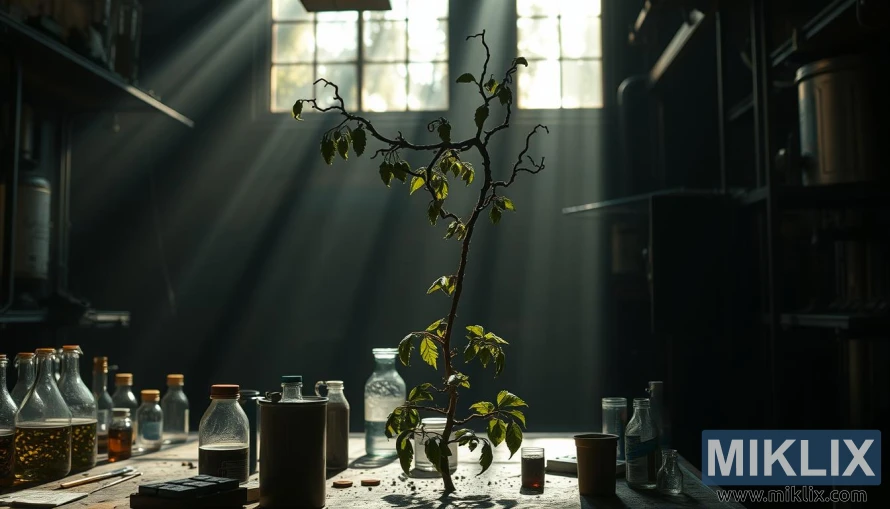Image: Gargoyle Hops Brewing Lab
Published: September 12, 2025 at 2:46:11 PM UTC
Last updated: September 27, 2025 at 8:15:10 AM UTC
A gargoyle-shaped hop plant dominates a shadowy brewing lab, with beakers and eerie light hinting at the challenges of unique hop brewing.
In the dim, moody confines of what appears to be an improvised brewing laboratory, a surreal and almost alchemical scene unfolds. At the center of a cluttered wooden workbench stands a solitary plant, its presence commanding and otherworldly. Its slender, twisted branches arc outward in unnatural directions, evoking the imagery of skeletal fingers reaching toward the fractured shafts of light spilling through grimy windows high above. The sparse but vibrant leaves cling to the gnarled limbs with a stubborn resilience, their subtle green hue punctuating the otherwise muted palette of shadows, glass, and aged wood. Though fragile in stature, the plant’s silhouette radiates an eerie authority, as though it were less a natural specimen and more a conjured guardian, the living embodiment of some experimental hop variety known only to the most daring brewers.
Surrounding this uncanny centerpiece is a chaotic arrangement of brewing paraphernalia. Glass bottles of varied shapes and sizes, some filled with amber liquids, others with cloudy or translucent solutions, are scattered across the bench in no discernible order. Small beakers and test tubes lie nestled among notebooks, crumpled scraps of paper, and half-forgotten implements of measurement. The mess suggests a space not of meticulous science but of feverish trial and error, a workshop where the pursuit of innovation supersedes neatness. Every object seems to tell a fragment of a story—the stubborn persistence of failed batches, the small triumphs of discovery, and the restless tinkering of someone determined to harness the plant’s hidden potential.
The atmosphere is thickened by the interplay of light and shadow. Dust motes hang suspended in the beams that cut through the air from the cracked windows, each ray illuminating the edges of glass vessels and the tender veins of the plant’s leaves. The backlighting enhances the sense of mystery, casting long silhouettes that stretch across the bench like omens. The surrounding corners of the room remain swallowed in darkness, their contents barely discernible, reinforcing the feeling that this plant and this bench represent the focal point of a secretive ritual. The effect is simultaneously reverent and ominous, as though the viewer has stumbled upon a sacred experiment not meant for ordinary eyes.
The mood of the scene balances uneasily between wonder and apprehension. On one hand, the delicate new growth of the hop plant suggests life, renewal, and the promise of invention—a glimpse at how nature might be coaxed into reshaping the sensory boundaries of beer. On the other, the warped, almost grotesque form of its branches conveys defiance, a hint of menace, and the difficulty of mastering such a force. It embodies the very duality of brewing itself: the tension between control and chaos, between artistry and unpredictability.
The choice of camera angle, slightly low and tilted upward, elevates the plant into a looming figure that dominates the room. It becomes less a simple organism and more a character with presence, a symbol of the trials and challenges that brewers face when wrestling with untamed hop varieties. The surrounding laboratory—messy, dark, and infused with a sense of secrecy—serves as the perfect stage for this brewing drama. Together, plant and setting evoke not just the science of fermentation, but the mythology of brewing: a reminder that each glass of beer carries within it an echo of struggle, discovery, and the transformative magic that happens when nature and human ambition collide.
The image is related to: Hops in Beer Brewing: Gargoyle

